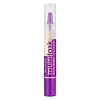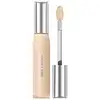Essence Multitask Concealer Versus Haus Labs By Lady Gaga Triclone Skin Tech Hydrating Concealer with Fermented Arnica
What's inside
What's inside
 Key Ingredients
Key Ingredients

 Benefits
Benefits

 Concerns
Concerns

No concerns
 Ingredients Side-by-side
Ingredients Side-by-side

Water
Skin ConditioningTalc
AbrasiveCoco-Caprylate/Caprate
EmollientIsododecane
EmollientPolyglyceryl-4 Isostearate
EmulsifyingGlycerin
HumectantC13-15 Alkane
SolventSucrose Acetate Isobutyrate
Disteardimonium Hectorite
StabilisingPolyglyceryl-4 Oleate
EmulsifyingDiatomaceous Earth
AbrasiveMagnesium Sulfate
Helianthus Annuus Seed Oil
EmollientCaprylic/Capric Triglyceride
MaskingTocopherol
AntioxidantHyaluronic Acid
HumectantHydrolyzed Hyaluronic Acid
HumectantSodium Hyaluronate Crosspolymer
HumectantSodium Hyaluronate
HumectantPolyglyceryl-3 Polyricinoleate
EmulsifyingPaullinia Cupana Seed Extract
Skin ConditioningPropanediol
SolventLysine
Skin ConditioningHydrolyzed Glycosaminoglycans
HumectantEthylhexylglycerin
Skin ConditioningSodium Lauroyl Glutamate
Caffeine
Skin ConditioningMagnesium Chloride
Beta-Sitosterol
Emulsion StabilisingSqualene
EmollientPhenoxyethanol
PreservativeAluminum Hydroxide
EmollientCI 77491
Cosmetic ColorantCI 77492
Cosmetic ColorantCI 77499
Cosmetic ColorantCI 77891
Cosmetic ColorantWater, Talc, Coco-Caprylate/Caprate, Isododecane, Polyglyceryl-4 Isostearate, Glycerin, C13-15 Alkane, Sucrose Acetate Isobutyrate, Disteardimonium Hectorite, Polyglyceryl-4 Oleate, Diatomaceous Earth, Magnesium Sulfate, Helianthus Annuus Seed Oil, Caprylic/Capric Triglyceride, Tocopherol, Hyaluronic Acid, Hydrolyzed Hyaluronic Acid, Sodium Hyaluronate Crosspolymer, Sodium Hyaluronate, Polyglyceryl-3 Polyricinoleate, Paullinia Cupana Seed Extract, Propanediol, Lysine, Hydrolyzed Glycosaminoglycans, Ethylhexylglycerin, Sodium Lauroyl Glutamate, Caffeine, Magnesium Chloride, Beta-Sitosterol, Squalene, Phenoxyethanol, Aluminum Hydroxide, CI 77491, CI 77492, CI 77499, CI 77891
Water
Skin ConditioningGlycerin
HumectantDiphenylsiloxy Phenyl Trimethicone
Skin ConditioningTrimethylsiloxysilicate
EmollientCaprylyl Methicone
Skin ConditioningLauryl Polyglyceryl-3 Polydimethylsiloxyethyl Dimethicone
Skin ConditioningC13-15 Alkane
SolventIsododecane
EmollientDimethicone
EmollientMethyl Trimethicone
Skin ConditioningPolypropylsilsesquioxane
Phenyl Trimethicone
Skin ConditioningDisteardimonium Hectorite
StabilisingPolymethylsilsesquioxane
Magnesium Sulfate
Acrylates/Dimethicone Copolymer
Skin ConditioningArnica Montana Flower Extract
MaskingNiacinamide
SmoothingSqualane
EmollientHydrolyzed Hyaluronic Acid
HumectantColeus Forskohlii Root Extract
EmollientSodium Hyaluronate
HumectantHyaluronic Acid
HumectantPseudozyma Epicola/Camellia Sinensis Seed Oil Ferment Extract Filtrate
HumectantPrunus Armeniaca Kernel Oil
MaskingPseudozyma Epicola/Apricot Kernel Oil/Olive Fruit Oil/Sunflower Seed Oil/Sweet Almond Oil/(Angelica Gigas/Lithospermum Erythrorhizon) Root Extract Ferment Extract Filtrate
Solanum Lycopersicum Fruit Extract
AntioxidantDunaliella Salina Extract
Skin ConditioningSodium Acetylated Hyaluronate
HumectantSodium Hyaluronate Crosspolymer
HumectantPseudanabaena Galeata Extract
Skin ConditioningHydrolyzed Sodium Hyaluronate
Skin ConditioningTocopherol
AntioxidantPotassium Hyaluronate
Skin ConditioningPseudozyma Epicola/Sunflower Seed Oil Ferment Extract Filtrate
Emulsion StabilisingBetaine
HumectantHydroxypropyltrimonium Hyaluronate
Caprylyl Glycol
EmollientAloe Barbadensis Leaf Extract
EmollientSorbitan Sesquioleate
EmulsifyingPolyglyceryl-3 Polydimethylsiloxyethyl Dimethicone
Skin ConditioningAcrylates/Polytrimethylsiloxymethacrylate Copolymer
Skin Conditioning1,2-Hexanediol
Skin ConditioningEthylhexylglycerin
Skin ConditioningDimethicone/Vinyl Dimethicone Crosspolymer
Skin ConditioningCetearyl Dimethicone/Vinyl Dimethicone Crosspolymer
EmollientTriethoxycaprylylsilane
Xanthan Gum
EmulsifyingSilica Silylate
EmollientAluminum Hydroxide
EmollientBoron Nitride
AbsorbentCI 77491
Cosmetic ColorantCI 77891
Cosmetic ColorantWater, Glycerin, Diphenylsiloxy Phenyl Trimethicone, Trimethylsiloxysilicate, Caprylyl Methicone, Lauryl Polyglyceryl-3 Polydimethylsiloxyethyl Dimethicone, C13-15 Alkane, Isododecane, Dimethicone, Methyl Trimethicone, Polypropylsilsesquioxane, Phenyl Trimethicone, Disteardimonium Hectorite, Polymethylsilsesquioxane, Magnesium Sulfate, Acrylates/Dimethicone Copolymer, Arnica Montana Flower Extract, Niacinamide, Squalane, Hydrolyzed Hyaluronic Acid, Coleus Forskohlii Root Extract, Sodium Hyaluronate, Hyaluronic Acid, Pseudozyma Epicola/Camellia Sinensis Seed Oil Ferment Extract Filtrate, Prunus Armeniaca Kernel Oil, Pseudozyma Epicola/Apricot Kernel Oil/Olive Fruit Oil/Sunflower Seed Oil/Sweet Almond Oil/(Angelica Gigas/Lithospermum Erythrorhizon) Root Extract Ferment Extract Filtrate, Solanum Lycopersicum Fruit Extract, Dunaliella Salina Extract, Sodium Acetylated Hyaluronate, Sodium Hyaluronate Crosspolymer, Pseudanabaena Galeata Extract, Hydrolyzed Sodium Hyaluronate, Tocopherol, Potassium Hyaluronate, Pseudozyma Epicola/Sunflower Seed Oil Ferment Extract Filtrate, Betaine, Hydroxypropyltrimonium Hyaluronate, Caprylyl Glycol, Aloe Barbadensis Leaf Extract, Sorbitan Sesquioleate, Polyglyceryl-3 Polydimethylsiloxyethyl Dimethicone, Acrylates/Polytrimethylsiloxymethacrylate Copolymer, 1,2-Hexanediol, Ethylhexylglycerin, Dimethicone/Vinyl Dimethicone Crosspolymer, Cetearyl Dimethicone/Vinyl Dimethicone Crosspolymer, Triethoxycaprylylsilane, Xanthan Gum, Silica Silylate, Aluminum Hydroxide, Boron Nitride, CI 77491, CI 77891
 Reviews
Reviews

Ingredients Explained
These ingredients are found in both products.
Ingredients higher up in an ingredient list are typically present in a larger amount.
Aluminum Hydroxide is a form of aluminum. It can be naturally found in nature as the mineral gibbsite. In cosmetics, Aluminum Hydroxide is used as a colorant, pH adjuster, and absorbent.
As a colorant, Aluminum Hydroxide may add opacity, or reduce the transparency. Aluminum hydroxide is contains both basic and acidic properties.
According to manufacturers, this ingredient is an emollient and humectant. This means it helps hydrate the skin.
In medicine, this ingredient is used to help relieve heartburn and help heal ulcers.
There is currently no credible scientific evidence linking aluminum hydroxide in cosmetics to increased cancer risk.
Major health organizations allow the use of aluminum hydroxide in personal care products and have not flagged it as a carcinogenic risk at typical usage levels.
Learn more about Aluminum HydroxideC13-15 Alkane is a group of alkanes with 13 to 15 carbon atoms in the alkyl chain.
It is a solvent and texture enhancer. Solvents are used to keep ingredients together in a product. They can help dissolve ingredients to stable bases or help evenly distribute ingredients throughout the product.
Ci 77491 is also hydrated iron III oxide. It's sole purpose is to give a red/pink hue to products.
Iron III oxides are classified as inorganic chemicals for coloring.
Synthetically created Ci 77491 is considered safer than those naturally found. This is because the synthetically created version may contain less impurities. Iron oxides are generally non-toxic and non-allergenic.
Learn more about CI 77491Ci 77891 is a white pigment from Titanium dioxide. It is naturally found in minerals such as rutile and ilmenite.
It's main function is to add a white color to cosmetics. It can also be mixed with other colors to create different shades.
Ci 77891 is commonly found in sunscreens due to its ability to block UV rays.
Learn more about CI 77891Disteardimonium Hectorite comes from the clay mineral named hectorite. It is used to add thickness to a product.
It can also help stabilize a product by helping to disperse other ingredients.
Hectorite is a rare, white clay mineral.
Learn more about Disteardimonium HectoriteEthylhexylglycerin (we can't pronounce this either) is commonly used as a preservative and skin softener. It is derived from glyceryl.
You might see Ethylhexylglycerin often paired with other preservatives such as phenoxyethanol. Ethylhexylglycerin has been found to increase the effectiveness of these other preservatives.
Glycerin is already naturally found in your skin. It helps moisturize and protect your skin.
A study from 2016 found glycerin to be more effective as a humectant than AHAs and hyaluronic acid.
As a humectant, it helps the skin stay hydrated by pulling moisture to your skin. The low molecular weight of glycerin allows it to pull moisture into the deeper layers of your skin.
Hydrated skin improves your skin barrier; Your skin barrier helps protect against irritants and bacteria.
Glycerin has also been found to have antimicrobial and antiviral properties. Due to these properties, glycerin is often used in wound and burn treatments.
In cosmetics, glycerin is usually derived from plants such as soybean or palm. However, it can also be sourced from animals, such as tallow or animal fat.
This ingredient is organic, colorless, odorless, and non-toxic.
Glycerin is the name for this ingredient in American English. British English uses Glycerol/Glycerine.
Learn more about GlycerinHyaluronic acid is naturally found in healthy skin. It is a humectant, meaning it draws moisture to your skin.
This ingredient helps hydrate, soothe, and protect the skin.
What makes hyaluronic acid so hydrating? It has the capacity to bind or hold large amounts of water.
Fun fact: It is already naturally found in our bodies, such as the fluids of our eyes and our joints.
Studies find this ingredient to have anti-inflammatory and anti-microbial properties. This can help speed up wound-healing.
Hyaluronic acid can be irritating if the molecule has a low-molecular weight, or if the molecules are small.
One study found low-molecular weight hyaluronic acid to be pro-inflammatory, meaning some people may experience irritation. This is because our bodies use hyaluronic acid in the wound-healing process to signal to our bodies, via irritation, that something needs healing.
The same study found high-molecular weight hyaluronic acid to be anti-inflammatory.
These are some other common types of Hyaluronic Acid:
Learn more about Hyaluronic AcidHydrolyzed Hyaluronic Acid is a form of hyaluronic acid. It is created by the hydrolysis of hyaluronic acid with a high molecular weight. Once created, Hydrolyzed Hyaluronic Acid has a low molecular weight.
Low molecular weight HA has been shown to hydrate and increase elasticity of the skin. Increasing elasticity is also associated with reduction of wrinkle depth.
One study found topical low molecular weight hyaluronic acid may be considered for the treatment of rosacea in the adult population. However, we always recommend speaking with a professional about your skin concerns.
Hyaluronic acids are a humectant. This means they draw moisture from the air. Hyaluronic acids help moisturize, soothe, and protect the skin.
Read more about other common forms of hyaluronic acid:
Learn more about Hydrolyzed Hyaluronic AcidIsododecane is a fragrance, emollient, and solvent.
As an emollient, it helps your skin stay soft and hydrated. Emollients help trap moisture into your skin.
Isododecane's role as a solvent makes it a great texture enhancer. It spreads smoothly on skin and does not leave a sticky feeling behind. Isododecane also helps prevent color transfer in makeup products.
Isododecane is not absorbed into skin.
Learn more about IsododecaneMagnesium Sulfate is a salt. More specifically, it is an epsom salt, or the bath salt used to help relieve muscle aches.
Despite having ‘sulfate’ in the name, it isn’t a surfactant or cleansing agent like sodium lauryl sulfate. Unlike those sulfates, magnesium sulfate doesn’t have the same cleansing or foaming properties (it's simply a type of salt).
In cosmetics, Magnesium Sulfate is used to thicken a product or help dilute other solids. It is a non-reactive and non-irritating ingredient.
One study shows magnesium deficiency may lead to inflammation of the skin. Applying magnesium topically may help reduce inflammation.
You can find this ingredient in sea water or mineral deposits.
Learn more about Magnesium SulfateSodium Hyaluronate is hyaluronic acid's salt form. It is commonly derived from the sodium salt of hyaluronic acid.
Like hyaluronic acid, it is great at holding water and acts as a humectant. This makes it a great skin hydrating ingredient.
Sodium Hyaluronate is naturally occurring in our bodies and is mostly found in eye fluid and joints.
These are some other common types of Hyaluronic Acid:
Learn more about Sodium HyaluronateSodium Hyaluronate Crosspolymer is a type of hyaluronic acid. In fact, it is modified version of hyaluronic acid.
The structure of Sodium Hyaluronate Crosspolymer allows it to stay in the skin's top layer for a longer period of time. This allows for even more hydration and humectant action than hyaluronic acid.
These are some other common types of Hyaluronic Acid:
Learn more about Sodium Hyaluronate CrosspolymerTocopherol (also known as Vitamin E) is a common antioxidant used to help protect the skin from free-radicals and strengthen the skin barrier. It's also fat soluble - this means our skin is great at absorbing it.
Vitamin E also helps keep your natural skin lipids healthy. Your lipid skin barrier naturally consists of lipids, ceramides, and fatty acids. Vitamin E offers extra protection for your skin’s lipid barrier, keeping your skin healthy and nourished.
Another benefit is a bit of UV protection. Vitamin E helps reduce the damage caused by UVB rays. (It should not replace your sunscreen). Combining it with Vitamin C can decrease sunburned cells and hyperpigmentation after UV exposure.
You might have noticed Vitamin E + C often paired together. This is because it is great at stabilizing Vitamin C. Using the two together helps increase the effectiveness of both ingredients.
There are often claims that Vitamin E can reduce/prevent scarring, but these claims haven't been confirmed by scientific research.
Learn more about TocopherolWater. It's the most common cosmetic ingredient of all. You'll usually see it at the top of ingredient lists, meaning that it makes up the largest part of the product.
So why is it so popular? Water most often acts as a solvent - this means that it helps dissolve other ingredients into the formulation.
You'll also recognize water as that liquid we all need to stay alive. If you see this, drink a glass of water. Stay hydrated!
Learn more about Water